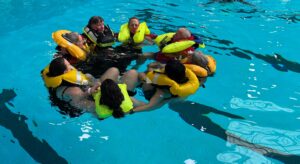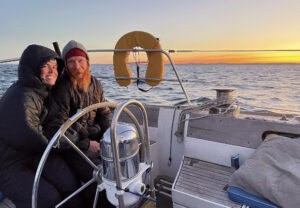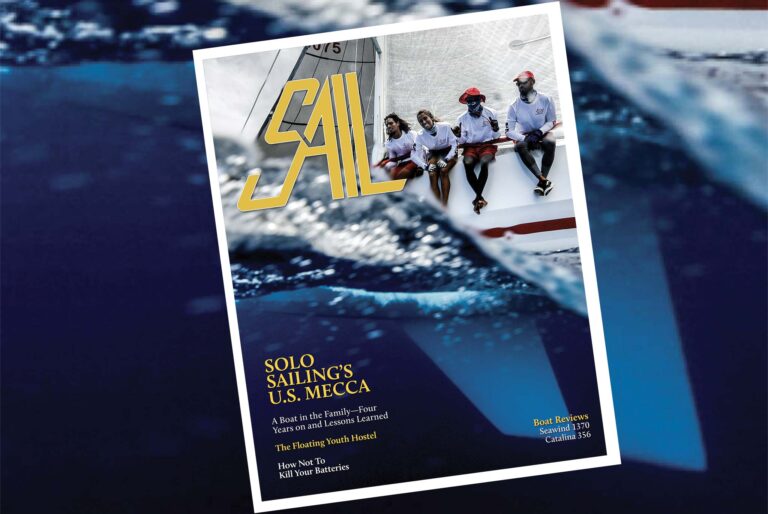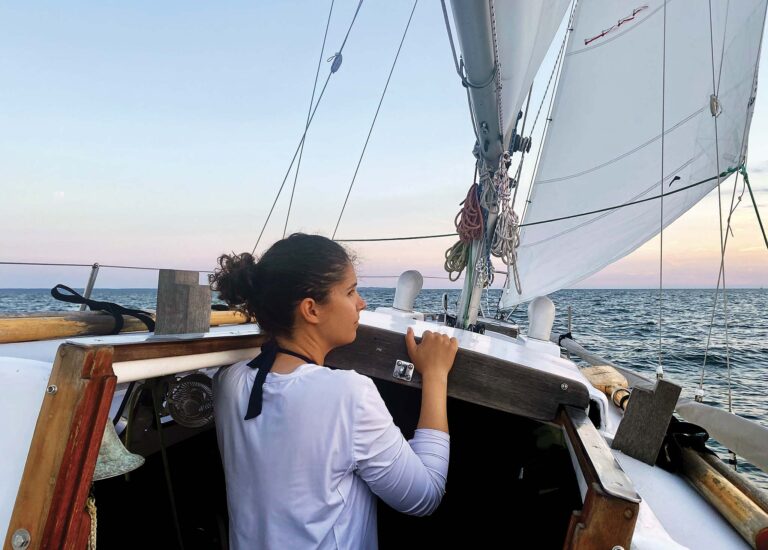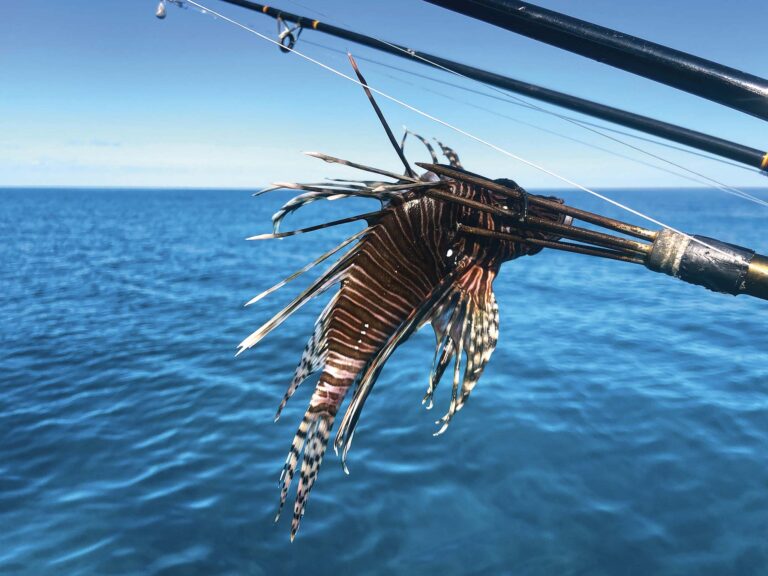
Last month, Donald McLennan took us through the basics of weather routing tools for cruisers. In part 2 of our series on weather routing, we take a closer look at some of the programs available for the sailing community.
Weather route optimization is based on the fastest time to navigate a route taking into account the weather conditions and boat characteristics. The isochrone method, first proposed in 1950s, is based on a recursive branching calculation of the distance traveled over each segment’s course at varying angles. The key is to use a fixed time interval and find the route with the maximum distance traveled. For a given position and time, the GRIB data gives forecasted wind conditions, and the boat’s performance data gives the speed. Multiplying by time gives the distance covered for that branch. All combinations of distance traveled for each branch are calculated and combined and the route with the maximum distance covered will be the optimal route.
Variations exist for calculating the route with fastest time or safest course, routing for speed versus comfort, routing around land or other obstacles, and avoiding high wind conditions.
The more sophisticated programs provide options for configuring the optimization. A few of the key options are the isochrone interval (defaults to three hours), limits on wind speeds and wave heights, and adjusting the polars. Expedition, Nobeltec and Weather4D allow setting up multiple sailplans, including heavy weather and light-air conditions, each with different performance targets. Most of the programs factor ocean tides and currents into their calculations.
Route optimization is simply a tool to supplement your routing decision. The best computer models can’t replace common sense and judgment when setting the course. Additional weather information such as weather faxes will help in anticipating changes in weather.
Weather Routing Tools

One of the questions that prompted my review of the options available for weather routing was how Weather4D’s routing feature compared to more established tools. The following programs were configured with the same route, boat polar data and GRIB files, and compared the optimized routes.
These programs span the available options for recreational cruisers and racers, computer platforms and price points. Surprisingly enough, all of these programs produced similar optimized routes, especially during the first few days of the weather forecast. The differences appear to be due to their default settings, factoring in ocean waves and currents, internal calculations and routing toward the finish.
Weather4D
Weather4D is an outstanding iOS app for downloading and visualizing weather data. In addition, the Pro version ($39.99) offers a weather routing feature that works remarkably well. The app downloads weather data, defined by zones that specify the coverage area, the resolution, number of days, time interval and weather data elements. In addition, you can download and import weather data from SailDocs or other GRIB providers.
Weather4D connected via a satellite phone is probably the easiest way to download GRIB data and optimize routes on the iPad. The app is not without problems, though. All of the import/export features are done through email or iOS “Open In” apps. In the absence of a local WiFi server, this is a problem while underway (iTunes or other apps can help transfer files). I found Weather4D’s downloaded GRIB file to be generally larger than the corresponding request from SailDocs. This may be due to including wind-gusts and primary wave data found in the file. The routing option is very sensitive to the input parameters and may stop with an ambiguous error message. Often the cause is the start date/time that falls outside the available GRIB data, a route with intermediate waypoints or crossing too close to land. Once the route optimization is working, I found optimizer to work very well.
For the convenience of a single app on the iPad, Weather4D is certainly a consideration for use while underway. weather4d.com

PredictWind
PredictWind claims to have the most accurate wind forecast data model available. PredictWind utilizes data from the Canadian Met Centre (CMC) and the NOAA Global Forecast System (GFS). It offers full global coverage at 50km resolution. Additionally, its model incorporates local variables, such as sea breezes and landmasses into its higher resolution forecasts, with 1km resolution at one-hour intervals and 8km resolution at three-hour intervals for most coastal sailing areas worldwide. For coastal sailing, the higher resolution data will more accurately represent local wind conditions.
PredictWind’s online website provides tools for weather forecasts, weather routing, departure planning and forecast e-mail alerts. It offers iOS and Android apps that function similarly to tihs online website. Additionally, its offshore desktop program (PC, Mac, iOS and Android) makes downloading GRIB data and weather routing simple and is specifically designed for satellite and SSB connections.
PredictWind’s weather routing feature is by far the easiest to use, though it lacks the more complex routing options found in other programs. To use it, you drop and drag the start, intermediate and destination waypoints by moving colored pins on the display. Options include routing for fastest time or comfort (to avoid adverse wind and wave conditions), importing your boat’s wind and wave polars, adjusting your boat’s polars by a percentage, a motoring option for low wind speeds, and using ocean and tidal currents in the optimization.
PredictWind is a subscription service, with the weather-routing feature included in the Standard package, at $79 for three months or $199 per year, or the Professional package, with higher-resolution data and ocean and tidal currents at $199 for three months or $499 per year.
The key advantages of PredictWind’s routing service is the ability to compare the optimized routes generated from the four forecast models (PWG,PWC,GFS, CMC). Compared with traditional weather-routing tools, which rely on a single forecast model, this gives you a greater level of confidence in the route and forecasts. Another outstanding feature is the optimized route’s download file size. Since the route is calculated on the server, the total download is only 1 percent of the equivalent GRIB data required by other weather routing software. This is a tremendous advantage when offshore using satellite and SSB communications. If you’re planning on using PredictWind while racing, be sure to check the sailing instructions, which may make allowances for paid weather services (e.g., not violating the “freely available” clause from Rule 41 of the Racing Rules of Sailing). predictwind.com
Expedition
Expedition was developed in the mid 1990’s and claims to be “simply the best tactical and navigation software available.” Expedition is targeted at serious racing enthusiasts and offers all the tools you may need in one integrated software package. Expedition includes an advanced chartplotter that supports charts from several sources, route planning and navigation tools, managing boat details including polars and multiple sail plans, weather route optimization, and real-time display of the boat’s instruments.
Where Expedition works beautifully is in the downloading and management of weather data, and optimizing the route. Weather data can be downloaded directly from SailDocs, NOAA direct, Oceans, PredictWind and others. To download a GRIB file, simply select the forecast source by marking a region on the chart and download. Multiple GRIB files can be compared and used in the optimization. Optimization settings have similar settings, including isochrones interval, optimal routing resolution, extending forecast in time, avoiding high winds and scaling the polar speeds by percentages.
At $1,295, Expedition is fairly expensive. But if you are looking for a single integrated Windows-based package, it is by far a superior product. expeditionmarine.com
Bluewater Racing
Bluewater Racing is a free program for long-distance racing and cruising. Bluewater Racing combines tools for basic chart management, polar data management, managing and viewing GRIB files and route optimization. The key to using this program is the “Route Manager,” which ties together the route, the boat’s polars and the optimizer settings. The resulting optimized route is nearly identical to the other optimized routes.
This is a no-frills weather routing application, but it still works very well. Bluewater Racing’s GRIB manager provides the most information about the data contained in the GRIB files. The program allows you to work with and combine multiple GRIB files for route optimization. One of its advantages is the ability to construct multiple routes and compare the time to sail, position, distance, ETA and wind at each point along the route. As with the GRIB details, all of the route segment details are readily visible. Bluewater Racing is certainly worth a look. bluewaterracing.com
qtVlm
qtVlm is an open-source program for managing virtual and real sailing that uses a boat’s polar data with GRIB weather data files to calculate the optimized route. The qtVlm program includes a GRIB download feature that downloads weather forecast data from zyGrib. One of its key features is the ability to recalculate an optimized route while underway. The program supports the common optimization options, including avoiding coasts and barriers, minimum and maximum wind speeds, maximum wave height and logarithmic convergence toward the finish.
My only criticism of qtVlm is that the documentation is mostly in French, with selected pages translated to English. It takes time to learn how to use this program, to set up marks, define the routing and convert the routing to a route. That said, the program is very intuitive and once a few basic concepts are mastered, it is easy to use.
The qtVlm program is worth a look. This may be my choice weather routing application for the Windows PC. sourceforge.net
Nobeltec
Nobeltec Timezero Trident is an elaborate all-in-one planning and navigation program with a stunning 3D navigation console that can be integrated with the boat’s electronics. The Sailing Plus Pack ($250 add-on) adds weather routing.
The boat’s polars and corresponding sailsets are manually entered in the polar management screen. Weather data is easily downloaded using the system’s built-in “Weather Update Wizard” or by repeating the last weather request. The downloaded GRIB files include pressure, wind, wave and currents data in three-hour intervals. GRIB files from other sources can also be opened. Weather routing is easily calculated by selecting the start and end points, and launching the routing. Additional optimization parameters include maximum wind speed, scaling the polars by percent, including winds, currents, and areas to avoid.
If you already have Nobeltec Timezero, the Sailing Plus Pack is a great way to extend your core navigation capabilities. nobeltec.com
Conclusion
When sailing long distances, whether for safety or comfort of fastest course, weather routing can be a valuable tool. The underlying key to any routing program is your preferred method for downloading weather data while underway. This factor alone may dictate the computer platform and tools available. When comparing the programs, the optimized routes were surprisingly similar. The grid resolution selected weather elements, and tides and currents all can have a dramatic effect on the optimized route.
For overall simplicity, I like the features of Weather4D on an iPad. For Windows PC (or Android), qtVlm looks promising and is certainly worth a look. SailDocs is one of the preferred methods for downloading GRIB files. PredictWind’s higher resolution forecasts may improve your optimized route, especially near coastal areas. By far the easiest to use is the PredictWind weather routing. With its service being online, the download files are incredibly small for Satellite/SSB communications.
If you look closely at the optimized route, you will see that they all aim for a course very close to the 1020mb pressure isobar. There’s something to be said for the old-timer’s simple route planning.
Application architect, software developer and sailor Donald McLennan reviews apps for SAIL while cruising the waters of Southern California aboard his Tartan 3500 with his wife, Laura, and daughters, Alexandra and Elizabeth
Read Part 1 Here
February 2016

